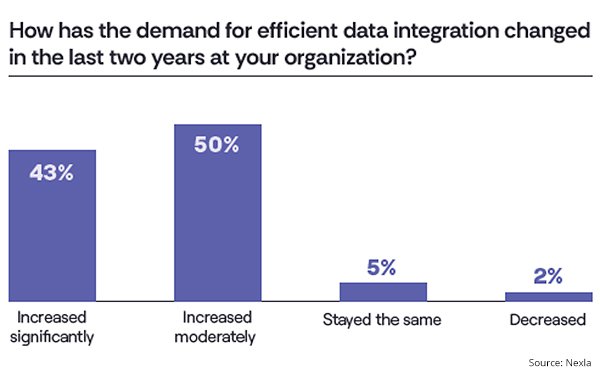
If there’s one thing data engineers dread, it’s a
middle-of-the night call that they have a problem.
These calls cause a major or significant impact for 56%, including burnout and reduced productivity, and more routine
trouble for 28%, according to The State of Data & AI Integration 2024-2025, a study from Nexla, conducted by Ascend2.
Yet the demand for efficient data integration has increased for
93% of firms, 43% significantly.
Of the companies polled, 87% are using three or more data integration tools, including:
- Data—API (API
Proxy) — 67%
- ETL — 45%
- Streaming — 41%
- iPass — 25%
- ELT —
25%
- R-ETL — 23%
advertisement
advertisement
Moreover, 75% of companies are using data integration for Gen AI projects, 27%
extensively.
But they face challenges, among them:
- Security concerns — 56%
- Security and government
— 44%
- Time it takes to set up/use data — 38%
- Incompatible data formats — 35%
- Importing from external vendors — 34%
- Data output into correct system and format — 34%
- Limited resources —
32%
- Lack of standardized processes — 29%
- Exporting to external partners — 29%
Moreover, 83% of data
professionals fear data backlogs in their organizations. These are caused by:
- Complexity of data sources and formats — 49%
- Insufficient manpower or skill gaps in data engineering teams — 43%
- Lack of automation in data integration tasks —
34%
- Inadequate infrastructure for handling large volumes of data — 33%
- Unmanageable number of project needs —
27%
Another complication is the number of partners or customers they are sharing data with, or plan to:
- 1
partner/customer — 4%
- 2-5 partners/customers — 21%
- 6-10 partners/customers —
26%
- 11-50 partners/customers — 21%
- 51-99
partners/customers — 10%
- 100+ partners/customers — 14%
- Not sure — 4%
How do they alert the right teams to fix data pipelines when they break? A majority of firms, at 61%, have an automated system in place, while 32%
use manual means. Another 5% have no system in place and 2% are unsure.
Ascend2 surveyed 314 data integration professionals. Of these, 42% work in firms with $500 million in revenue. And
25% report revenue of $250 million to 499.99 million, 22% $100 million to $249.99 million and 11% $50 million to $99.99 million.